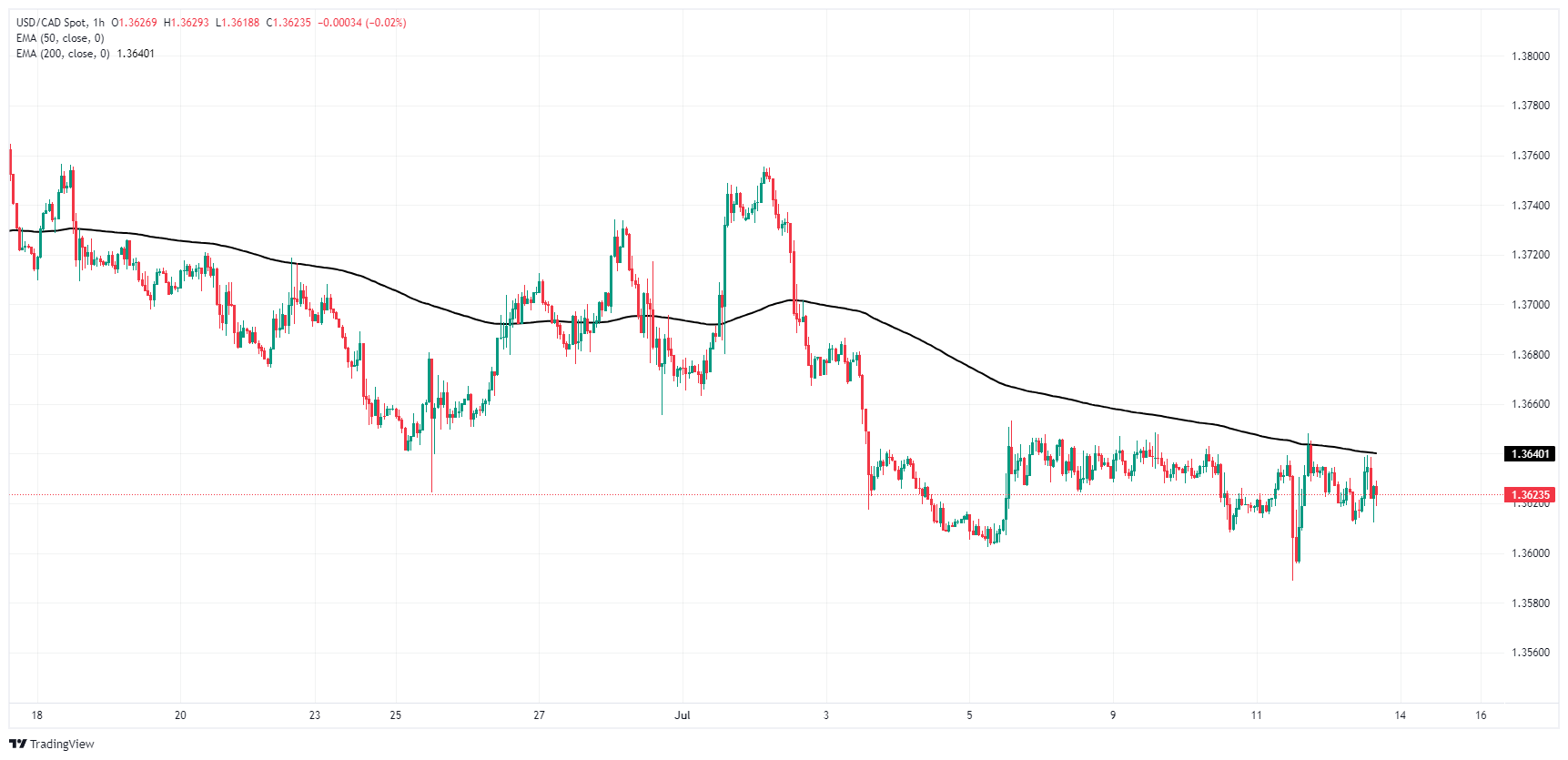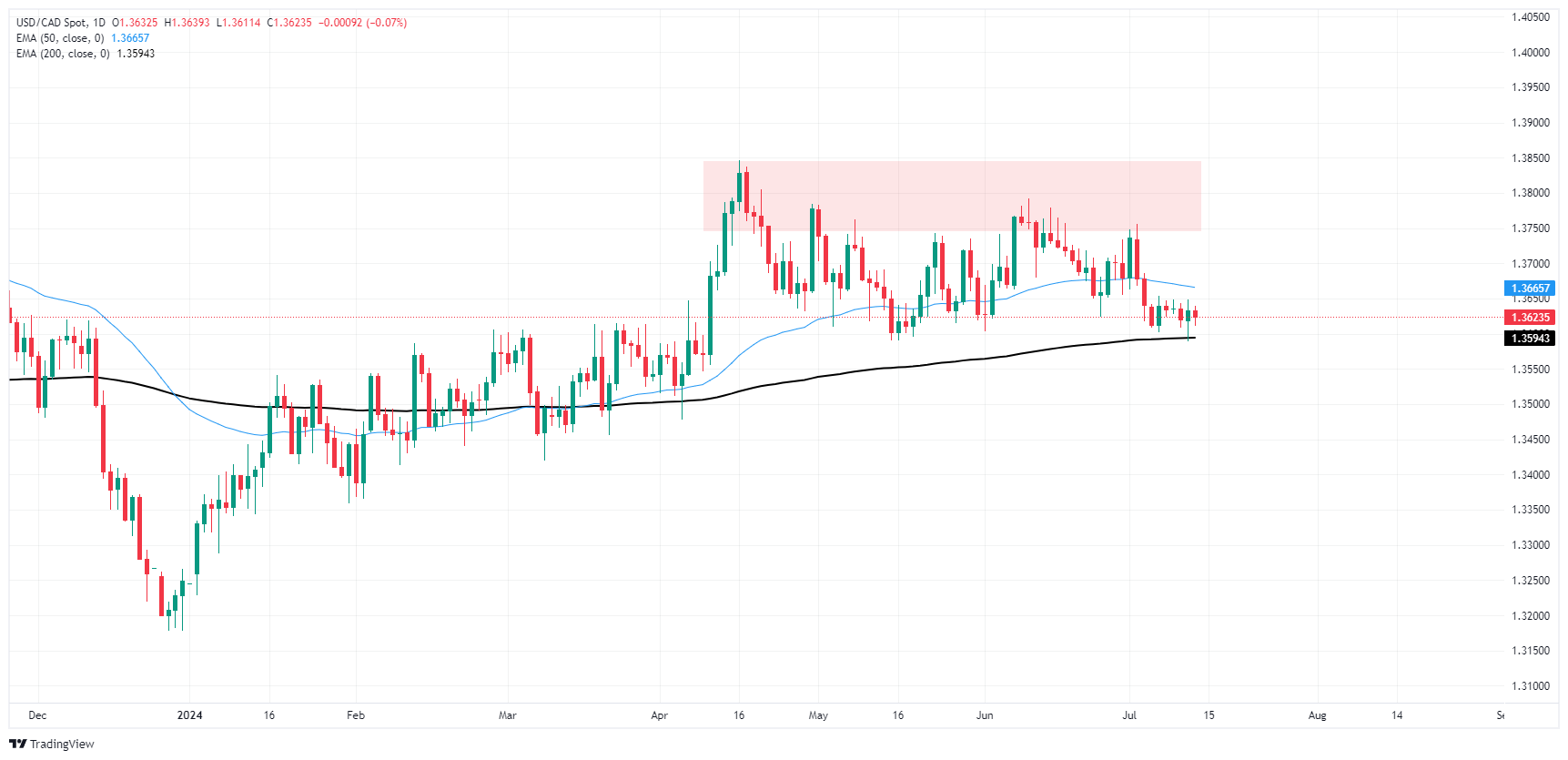- Phân tích
- Tin tức và các công cụ
- Tin tức thị trường
- Canadian Dollar softens on Friday as markets grapple with acceleration in US PPI inflation
Canadian Dollar softens on Friday as markets grapple with acceleration in US PPI inflation
- The Canadian Dollar backslid on Friday as CAD traders retreat for the weekend.
- Canada revealed another sharp contraction in new building permits.
- US PPI wholesale inflation accelerated, but markets are trying to shrug it off.
The Canadian Dollar (CAD) shed weight on Friday, falling to the bottom as one of the poorest-performing major currencies for the last session of the trading week. Broader markets are shaking off an unexpected acceleration of US Producer Price Index (PPI) wholesale inflation, instead focusing on cooling Consumer Price Index (CPI) inflation from earlier in the week.
Canada posted 2024’s second-steepest contraction in Building Permits in May, hobbling the CAD further and setting the Canadian Dollar up to churn on the low side as traders await next Tuesday’s Canadian CPI inflation print.
Daily digest market movers: Canadian Dollar stumbles on bad housing data
- Canadian Building Permits contracted 12.2% in May, the second-steepest decline in 2024.
- US core PPI wholesale inflation accelerated notably in June, rising to 3.0% YoY compared to the expected 2.5%.
- The previous period’s print was also revised higher to 2.6% from the initial 2.3%.
- MoM core US PPI rose 0.4% MoM, double the forecast 0.2% while the previous month’s print was likewise revised upwards to 0.3% from the initial 0.0%.
- The University of Michigan Consumer Sentiment Index for July declined to a seven-month low of 66.0 from the previous 68.2, reversing the forecast uptick to 68.5.
- Despite the upswing in producer-level inflation, markets are broadly leaning into the bullish side, focusing on Thursday’s cooler-than-expected CPI inflation print.
Technical analysis: USD/CAD swamped out in near-term midrange
The Canadian Dollar (CAD) is one of the poorest-performing currencies on Friday, shedding weight across the board and struggling to develop any meaningful momentum against the US Dollar. USD/CAD is stuck in a lurch just above the 1.3600 handle, and threatening to spiral out into a longer-running consolidation phase as the pair finds little reason to push too far in either direction.
Intraday bidding remains capped below the 200-hour Exponential Moving Average (EMA) at 1.3640, and tests to the low side are unable to find a foothold below 1.3600. Daily candlesticks are bolstered by the 200-day EMA at 1.2594, keeping a lid on downside pressure while a supply zone priced in above 1.3750 caps off any bullish attempts.
USD/CAD hourly chart
USD/CAD daily chart
Canadian Dollar FAQs
The key factors driving the Canadian Dollar (CAD) are the level of interest rates set by the Bank of Canada (BoC), the price of Oil, Canada’s largest export, the health of its economy, inflation and the Trade Balance, which is the difference between the value of Canada’s exports versus its imports. Other factors include market sentiment – whether investors are taking on more risky assets (risk-on) or seeking safe-havens (risk-off) – with risk-on being CAD-positive. As its largest trading partner, the health of the US economy is also a key factor influencing the Canadian Dollar.
The Bank of Canada (BoC) has a significant influence on the Canadian Dollar by setting the level of interest rates that banks can lend to one another. This influences the level of interest rates for everyone. The main goal of the BoC is to maintain inflation at 1-3% by adjusting interest rates up or down. Relatively higher interest rates tend to be positive for the CAD. The Bank of Canada can also use quantitative easing and tightening to influence credit conditions, with the former CAD-negative and the latter CAD-positive.
The price of Oil is a key factor impacting the value of the Canadian Dollar. Petroleum is Canada’s biggest export, so Oil price tends to have an immediate impact on the CAD value. Generally, if Oil price rises CAD also goes up, as aggregate demand for the currency increases. The opposite is the case if the price of Oil falls. Higher Oil prices also tend to result in a greater likelihood of a positive Trade Balance, which is also supportive of the CAD.
While inflation had always traditionally been thought of as a negative factor for a currency since it lowers the value of money, the opposite has actually been the case in modern times with the relaxation of cross-border capital controls. Higher inflation tends to lead central banks to put up interest rates which attracts more capital inflows from global investors seeking a lucrative place to keep their money. This increases demand for the local currency, which in Canada’s case is the Canadian Dollar.
Macroeconomic data releases gauge the health of the economy and can have an impact on the Canadian Dollar. Indicators such as GDP, Manufacturing and Services PMIs, employment, and consumer sentiment surveys can all influence the direction of the CAD. A strong economy is good for the Canadian Dollar. Not only does it attract more foreign investment but it may encourage the Bank of Canada to put up interest rates, leading to a stronger currency. If economic data is weak, however, the CAD is likely to fall.
© 2000-2024. Bản quyền Teletrade.
Trang web này được quản lý bởi Teletrade D.J. LLC 2351 LLC 2022 (Euro House, Richmond Hill Road, Kingstown, VC0100, St. Vincent and the Grenadines).
Thông tin trên trang web không phải là cơ sở để đưa ra quyết định đầu tư và chỉ được cung cấp cho mục đích làm quen.
Giao dịch trên thị trường tài chính (đặc biệt là giao dịch sử dụng các công cụ biên) mở ra những cơ hội lớn và tạo điều kiện cho các nhà đầu tư sẵn sàng mạo hiểm để thu lợi nhuận, tuy nhiên nó mang trong mình nguy cơ rủi ro khá cao. Chính vì vậy trước khi tiến hành giao dịch cần phải xem xét mọi mặt vấn đề chấp nhận tiến hành giao dịch cụ thể xét theo quan điểm của nguồn lực tài chính sẵn có và mức độ am hiểu thị trường tài chính.
Sử dụng thông tin: sử dụng toàn bộ hay riêng biệt các dữ liệu trên trang web của công ty TeleTrade như một nguồn cung cấp thông tin nhất định. Việc sử dụng tư liệu từ trang web cần kèm theo liên kết đến trang teletrade.vn. Việc tự động thu thập số liệu cũng như thông tin từ trang web TeleTrade đều không được phép.
Xin vui lòng liên hệ với pr@teletrade.global nếu có câu hỏi.















